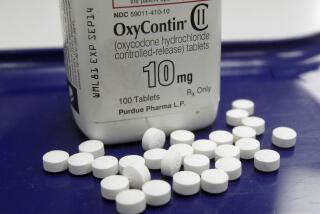Drug safety revisited
- Share via
If the U.S. Supreme Court were in the business of compensating victims of medical error because of the poignancy of their plight, Diana Levine wouldn’t be in suspense about whether the justices would rule in her favor. Levine, a guitarist and pianist from Vermont, developed gangrene after an anti-nausea drug was injected -- and hit an artery instead of a vein. Her arm had to be amputated, and Levine wants the court to uphold a verdict ordering the manufacturer of the drug to pay her $6.7 million.
But the Supreme Court usually doesn’t take cases out of sympathy for -- or hostility toward -- an individual. The reason the justices accepted this one is that Wyeth, the drug manufacturer, made an argument with far-reaching implications. Because its packaging includes safety warnings required by the Food and Drug Administration, Wyeth contended, it (and other companies) shouldn’t be sued in state courts if a drug harms someone.
Although this is a close case, Levine should prevail -- but not because of egregious misconduct by Wyeth. The company had used a warning approved by the FDA for the drug, Phenergan, that discouraged the method of injection used on Levine and noted that injection in an artery could lead to gangrene and amputation of a limb. Still, the warning should have been stronger.
Levine brought a malpractice suit against the clinic where she was treated and its personnel, and reached an out-of-court settlement. So why should Wyeth also be forced to pay her? The short answer is that the Vermont Supreme Court decided she was entitled to relief under state law. The long answer -- one the U.S. Supreme Court may give when it rules -- is that in enacting the Food, Drug and Cosmetic Act, Congress didn’t explicitly invoke its power to preempt state action.
Congress made matters clearer when it came to the regulation of medical devices, barring states from imposing “any requirement ... different from, or in addition to” federal rules. For that reason, the Supreme Court in February ruled 8 to 1 that a heart patient whose catheter malfunctioned couldn’t sue the manufacturer because the FDA had approved the device.
In Levine’s case, the court may reach the opposite result. But in doing so, it should rule narrowly and in a way that invites Congress to revisit this issue by requiring the FDA to improve its process for monitoring drugs that pose unreasonable risks. (A federal watchdog that doesn’t bark encourages the states to erect their own regulatory and judicial kennels.) Only then should Congress amend the act to make it clear that drug manufacturers don’t have to design a different label for every state.
More to Read
A cure for the common opinion
Get thought-provoking perspectives with our weekly newsletter.
You may occasionally receive promotional content from the Los Angeles Times.









